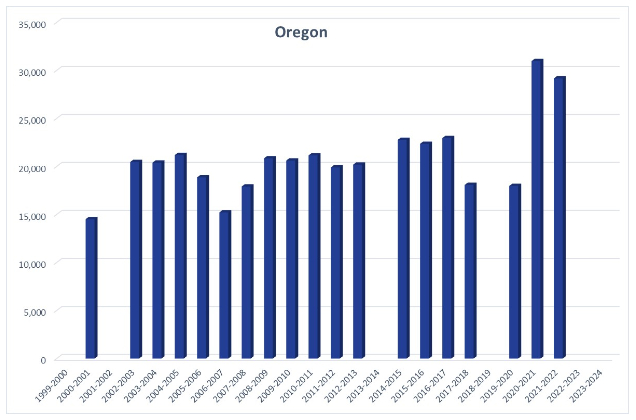Because Oregon requires a one-time notification, participation data are limited to new homeschoolers only.
History
Oregon, located in the western United States, legalized homeschooling in 1985.
Regulation
Oregon offers one option for homeschooling. Parents who want to homeschool their children, ages 6 to 18, must notify the local education service district electronically or by mail. The notification should include the student’s name, address, date of birth, and prior or current school or district. Annual notification is not required. See Or. Rev. Stat. §339.035 (2) and Or. Admin. Rules §581-021-0026 (1)(f), (4).
Oregon provides a standards guide, but parents do not have to adhere to the state’s suggestions and can select their own curriculum and instructional materials. The state does not have required subjects, record keeping, minimum instruction hours, or minimum parental education requirements.
New homeschool families have an 18-month “grace period” and do not require testing or assessments. However, after 18 months, homeschooled students must test in certain grades or every year if they participate in interscholastic activities. Parents may choose from a list of approved tests. It does not appear that funding is available for the required testing or that homeschool families can take the state assessment free of charge. If a child scores below the 15th percentile, the child must be retested within the year. If low performance occurs for three consecutive years, the superintendent could require the child to receive instruction from a certified teacher or attend a traditional school. See Or. Rev. Stat. §339.035(4) and Or. Admin. Rules §581-021-0026(7)(a), (b), and (d) for details.
Oregon views homeschools as existing outside the public system. Therefore, homeschooled students do not have access to public resources. However, homeschooled students do have access to interscholastic opportunities at their local public school. These opportunities are unfunded and not offered to other nonpublic students. Further, students may need to show academic progress and test annually to participate. See Or. Rev. Stat. §339.460 and Or. Admin. Rules §581-021-0333. The state acknowledges an obligation to identify all children with special needs within its boundaries. Deciding whether or not to provide special needs occurs at the district level.
State Data
Oregon collects and reports homeschool participation information. The state only requires a family report when they begin homeschooling and does not need to provide an annual update. The limited participation data makes it difficult to understand homeschooling participation trends and how many students homeschool in Oregon.

U.S. Census estimates indicate that around 8.3% of Oregon families homeschooled in the spring of 2020. That percentage increased to 13.0% by the fall of 2020. This was higher than the national average of 11.1% at this time. Based on U.S. Census data, our calculations indicate that about 6.53% of K-12 students in Oregon were homeschooled during the 2022-23 school year, and 7.03% during the 2023-24 school year. Due to survey changes, the data from 2020 reflects the percentage of households, while the data from following years reflects the percentage of students.
Cross-Sector Comparison
We cannot calculate a cross-sector comparison because we lack information on total homeschool participation.
School Choice Context
In addition to homeschooling, parents in Oregon have various educational choices available. These options include enrollment in traditional public schools, including inter- and intra-district choice, magnet, and charter schools. Oregon has no private school choice programs or public funding for homeschooling.
Commentary
Oregon could increase access for all nonpublic students to offerings at public schools, including extracurriculars and courses. They could also report more data they collect, such as student age, grade, and district. These efforts would remove barriers, and increase transparency.

-
13.0% Families
Around 13.0% of families in Oregon homeschooled during the height of the pandemic (Fall 2020).
-
1985 Legalized
Homeschooling was legalized in 1985 in the state of Oregon.
-

-
More Information
13.0% Families
Around 13.0% of families in Oregon homeschooled during the height of the pandemic (Fall 2020).
1985 Legalized
Homeschooling was legalized in 1985 in the state of Oregon.

More Information
Last updated March 2025.